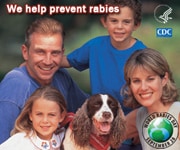Rabies in Manmade or Natural Disasters
Animals might be displaced during and after manmade or natural disasters, and they might require emergency sheltering. Animal rabies vaccination and exposure histories often are not available for displaced animals, and disaster response can create situations in which animal caretakers might lack appropriate training and previous vaccination.
In such situations, the following rabies prevention and control measures should be used to reduce the risk for rabies transmission and the need for human postexposure prophylaxis.
- Coordinate relief efforts of persons and organizations with the local emergency operations center before deployment;
- examine each animal for signs of rabies at a triage site;
- isolate animals exhibiting signs of rabies, pending evaluation by a veterinarian;
- ensure that all animals have a unique identifier;
- administer a rabies vaccination to all dogs, cats, and ferrets unless reliable proof of vaccination exists;
- adopt minimum standards for animal caretakers that include personal protective equipment, previous rabies vaccination, and appropriate training in animal handling;
- maintain documentation of animal disposition and location (e.g., returned to owner, died or euthanized, adopted, relocated to another shelter, address of new location);
- provide facilities to confine and observe animals involved in exposures; and
- report human exposures to appropriate public health authorities.
Page last reviewed: April 22, 2011

